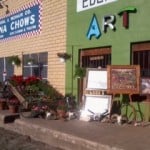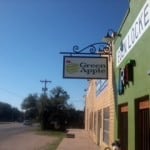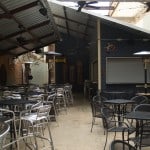
A news story from Garland, Texas, got me thinking about what you can do with a roofless building. We came up with a lot of ideas for empty buildings, so I knew we could do something with roofless buildings, too.
You probably have one in your downtown. Maybe a building burned, or maybe the roof just fell in. These things happen. Now you have an empty space, maybe with walls, or maybe just an open lot. What can you do with a roofless building?
The standard answer for small town governments has been to make a pocket park: a little green space, a bench or two, and that’s about it. Maybe a memorial or piece of art. Pocket parks are OK, but they aren’t the only possibility. There’s much more we can do.
This is a good place to apply the Placemaking concepts of “lighter, quicker, cheaper.” Try cheap and temporary setups to see what people in your town will actually use. Because I’ve seen a lot of pocket parks in small towns, but I’ve very, very, very rarely seen a person actually using one, and I’ve never seen a group or a crowd enjoying a pocket park. Which is a shame, really.
What could you do instead? My weekly newsletter readers and I came up with this list to inspire action on your own roofless buildings.
Before we get started, check for safety. Those formerly-interior walls and floors may need weather-sealing or shoring up. Make sure you get that done first before you start inviting people in.
Not-for-profit ideas
Things cities, towns, or organizations might do with lots they own, without much expectation of a direct return on investment.
Start a conversation. Start with your pocket park idea, but add lots of seating for lots of people in conversational groupings. One picnic table isn’t enough to draw a crowd and make it a lively place, so put lots of tables. Schedule a special day to have lunch there. Make it a community event. Like, every Friday, all of downtown has lunch together here. Hold your board meetings, chamber breakfasts or other regular events there. It’s good for you to get outdoors.
Make it a community garden or flower garden. Jerry Johnson, from JLJ Design Studio in Richardson, Texas, suggested these green ideas. Much more lively and gets more people involved than a plain pocket park. Watch out; Jerry has a lot more ideas coming up throughout this article.
Add a public restroom. Cara Carson with Main Street Enid, Oklahoma, shared a photo of this gorgeous pocket park with public restrooms in Tishomingo, Oklahoma. Trust me, visitors will appreciate an inviting public restroom.
Make an event space. Set up a little stage. Start recruiting anyone who gives lessons (music, dance, drama, writing) to hold student performances there. Just installing the stage doesn’t mean anything if no one uses it. The one in the photo below is in my hometown of Alva, Oklahoma, next to the library. There is a tiny stage in the far corner, big enough for one or maybe two performers.
Set up games and fun things to do together. Chess or checker boards, maybe, or domino tables, or poker tables. Or play equipment like parks have. Or interactive art-style things. Or human foosball. Jerry Johnson suggested lots of fun activities like bocce ball, croquet, shuffleboard or horseshoes. Here are lots of Placemaking examples that include play.
Make it a beach instead of a park. All you need is sand and beach chairs. Maybe an umbrella. Detroit did this, but your town could, too. Set it up for volleyball games or sand castle building, Jerry Johnson suggested.
Set up an outdoor living room. Make it comfy and home-like. (Hey, I’ve seen plenty of outdoor furniture that looked comfy and home-like.) Hold conversations there. CFRA did an outdoor living room in their town of 851 and convened a series of conversations with local people. It was a temporary art/community project, but makes perfect sense to try for a longer time in a roofless building.
Create an outdoor museum. Jerry Johnson came up with an idea of a rusted tractor graveyard, but you could make almost any kind of outdoor museum display. What weather-resistant or happily-rusty artifacts would tell the story of your town? Get brave and invite graffiti art on the walls. You can always paint over it again and again.
Walk-in theater. I hear about a lot of towns showing movies outdoors on the sides of buildings or on inflatable screens, so why not in a roofless building?
Park on it. Al Jones of Montana suggested creating parking for adjacent buildings, increasing their value. And no reason a parking lot can’t also serve part-time as a farmers market, flea market or any number of other uses listed here.
Recycle on it. Do you have a local recycle center? Jerry Johnson said that was another use to think of.
Let other people decide. Let community groups or school kids take over the empty space for a month, and give them a free hand. I’m betting some great ideas will happen. Maybe the ag kids want to do a petting zoo or an aviary, Jerry Johnson suggested.
Not-just-for-profit ideas:
Things individuals could do, and might even make a little money on. And yes, cities, towns and organizations could do these, too. I’m sure they could use some revenue.
Rent the space for special events. Try tastings and sampling events, demonstrations, lessons, or an outdoor yoga studio. You might have the most demand during the big festivals or events that already draw people downtown. That photo of the roofless building at the very top of this story is from my town. I think it would make a perfect overflow space for booths, food vendors or performances during our big arts festival instead of sitting empty all year-round.
Outdoor eating space. Rent to a nearby eatery for outdoor seating for the nice-weather season.
Food truck dining. Add tables and chairs, and a place for food trucks to park. That was the idea in the news story from Garland, Texas, that got me thinking. Robert Smith, who owns the lot featured in that news story, was kind enough to say howdy and share his website for 507 State Street. Joe Iliff from not-too-far-away Sanger, Texas, sent me the link to this video of the food truck event in Garland that was planned and pulled off in two weeks.
Allow street vendors and artisans. Brian Mininger said, “Charlottesville, Virginia, has a downtown pedestrian mall where the street used to be. They allow all different types of vendors. It makes for a great environment and a fun place to be. The same could be done with a roof less building.” Jerry Johnson added more commerce-friendly ideas, including a flea market or a “sell your own car” used car lot.
Set up a farmers market. Brian Mininger also suggested creating a farmers market. I really like how this would bring your farmers market right downtown.
Make a greenhouse. Al Jones came up with the greenhouse concept. Al said, “Cover the roof area with transparent plastic sheeting, add a fan for heat buildup, restore water and electrical service to the building, and use it as a greenhouse for high-value cooking herbs and spices for local restaurants, tended by the kitchen staffs. Many chefs maintain their own; it makes so much of a difference.”
Pop-up a village of shops. Use inexpensive garden sheds to create a bunch of tiny business spaces. Tionesta, Pennsylvania, did this with an empty lot. Now they have a bunch of businesses there, and it’s a kind of business incubator. It would work in a roofless building just as well as an empty lot.
Brainstorming for your town
These are the kind of things we brainstorm when I visit small towns. We get people together, I bring examples I’ve found all over, locals bring their knowledge of your people and the place, and not too surprisingly, we come up with better ideas together. If you’re interested in having me come to your town, contact me and we’ll talk about it.
A roofless gymnasium becomes an event space
Porterdale, Georgia, USA, has a huge community center and gymnasium, 12,000 square feet. It was built in 1939, burned in 2005 and was stabilized in 2012 and 2013. Downtown Director Teri Haler said it’s been a long, slow process, and has taken a lot of funding, but it’s now an event space that has hosted concerts, food festivals, and weddings. For a town with only 1,281 people, it’s now a huge asset instead of a huge eyesore.
- The Porterdale Gym and Community Center back in its heyday.
- The gym after the fire. Not much left but walls.
- Tuba Christmas Concert in 2014. Photo by Logan Spencer, Porterdale GA.
- July 4 concert, photo by Tim Haler.
- Ribbon Cutting on May 8, 2014. Photo by Current Events Productions, Covington GA.
- Taste of Newton food festival. Photo by Wade Dunn Jr. Photography.
The garden of Eden
Economic Development Coordinator Laura Bowden told me how Eden, Texas, has re-used several empty spaces. They took an old locker plant without a roof and turned it into a market place and an outdoor concert space. They also took an empty lot and made their own Garden of Eden. They also made a pocket garden with a memorial for all Veterans and use it to host Memorial Day and other veterans’ gatherings.
A tiny coffee shop sprouts inside a roofless building
Marci Penner, from Kansas Sampler Foundation, of course knew just where to find a roofless building being put to good use in Kansas: in Saint Francis, population 1,300. Union Square is now home to a coffee shop and outdoor events. Notice how they put a tiny building inside the footprint of the bigger building. You know that cost a lot less than reconstructing the whole thing, and it gives a usable indoor space for the coffee shop kitchen. See lots more photos on the Union Square Facebook page.
A Beer Garden in Paris
Catherine Sak, Executive Director of the Texas Downtown Association, made sure I knew about this one from Paris, Texas. Catherine was also how I found out about the original example in Garland, Texas, that kicked off this whole line of thinking. She’s a smart cookie.
107 Grand is a roofless building in Paris, Texas, finding new life as a beer garden. And doesn’t a beer garden sound so much more entertaining than just “building with no roof”? Cheri Bedford is the Paris Main Street Coordinator, and she sent along these photos.
Your homework assignment is:
Go look at an actual empty lot or roofless building in your downtown (or High Street). Stand there and think. Think about what might work in your town. How could you make that happen?

More ways to fill buildings: 101 Ways to Start More Tiny Businesses
If you need more business ideas, 101 Ways to Start More Tiny Businesses is a short ebook detailing ways to spread economic opportunity as well as why tiny businesses matter. Sign up here to download it and you’ll also get our weekly newsletters where Deb Brown and I share practical steps you can put into action right away to shape the future of your town. Download 101 Ways here.
I will never sell or rent your email address to anyone else because I wouldn’t like that either.
- About the Author
- Latest by this Author
Becky started Small Biz Survival in 2006 to share rural business and community building stories and ideas with other small town business people. She and her husband have a small cattle ranch and are lifelong entrepreneurs. Becky is an international speaker on small business and rural topics.




























Ann sent this comment by email:
“A couple years ago we were traveling for my son’s youth football games and one happened to be held in Laurens, Iowa. We arrived early and had a chance to bum around town a little and discovered this great community gathering space and learned the story of how it came to be (as told by a local businesswoman running the antique/gifts shop next door). We still talk about this neat space, and I’ve kept it in mind for our town as we have a couple old buildings that have needed transition…maybe someday we’ll also achieve a “Memory Lane” park like Laurens.”
Ann also sent this link to the Laurens, Iowa, parks page, where there are a couple of tiny photos and the park is described this way:
“Memory Lane is a recently constructed downtown park built through donations by individuals and businesses. There are pergolas, stone tables and benches, a water fountain, stage, and drinking fountain. It is a place of reunion and reflection, a place for positive conversation, and a place to remember those who have contributed to the Laurens community.”
Aaron Blair sent in this example, an open air Art Park – The Artpark on Pine in Albany, Georgia. Lots of amazing graffiti art, and a big vision for the future of the open air space.
The Art Park in Albany, Georgia, is changing again. Now a microbrewery is developing the site, and they’re going to keep the storefronts. News story: http://www.albanyherald.com/news/local/microbrewery-project-progressing-step-by-step/article_57ebb6b6-47a3-59a1-afbe-04908133259e.html
Don’t give up on your roofless buildings!
Here’s another idea for your empty lot: add bike tools and bike racks. Here’s an example in Brisbane, Australia: http://www.brisbanecyclist.com/forum/topics/bike-tool-station-at-southbank